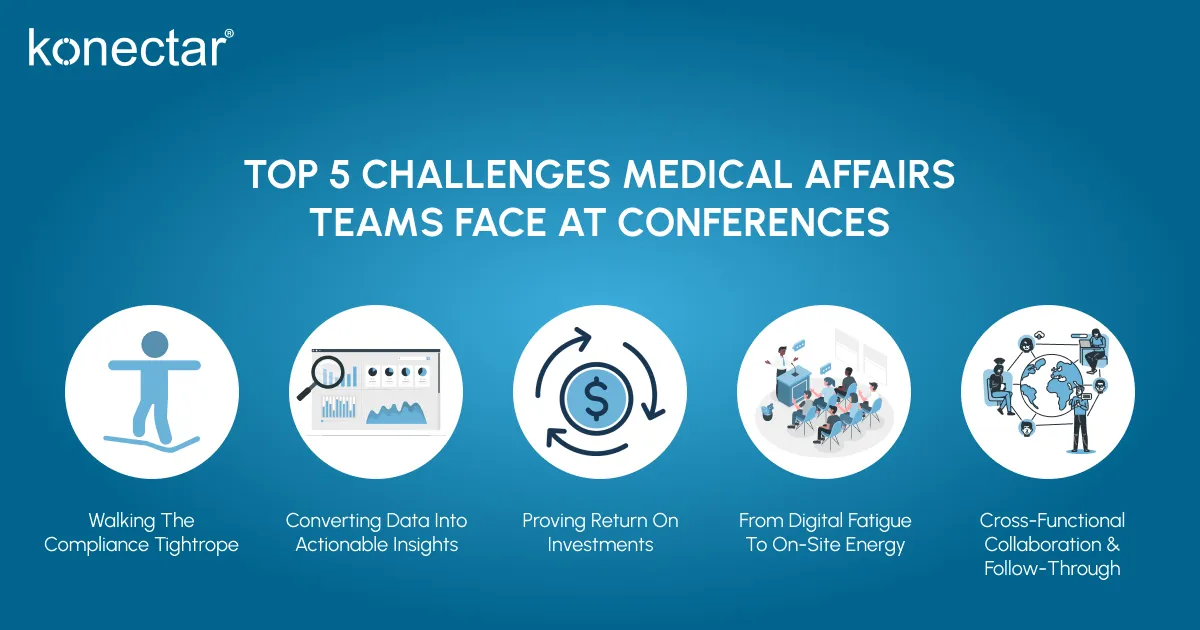13-08-2025
Top 5 Challenges Medical Affairs Teams Face at Conferences

Attending major scientific congresses is one of the highest-stakes activities for pharma teams. Done well, they unlock deeper scientific insights, strengthen key relationships, and create a competitive advantage. Done poorly, they become a missed opportunity — and a major budget sink.
This article explores the five most common hurdles Medical Affairs (MA) leaders face — and the practical, proven solutions to overcome them.
Walking the Compliance Tightrope
The Challenge:
Ever-evolving laws, shifting industry guidelines, and strict internal governance mean that scientific exchange can easily cross into non-compliant territory. Digital content, slides, and even social posts are all at risk.
Impact if Ignored:
- Potential legal or reputational damage
- Missed opportunities to share valuable data
- Reduced confidence from internal teams and external stakeholders
Solutions That Work:
- Include Compliance from the Start – Pair scientific content owners with compliance reviewers early in the process, not just before materials are shipped.
- Factor in Local vs. Global Rules – National regulations can be more restrictive than global ones. Research location-specific compliance laws before finalizing content.
Converting Data into Actionable Insights
The Challenge:
With hundreds of sessions to choose from, MA teams risk being overwhelmed by scattered notes that never make it into strategic action.
Impact if Ignored:
- Valuable insights go unshared or forgotten
- Missed alignment with cross-functional teams
- Reduced impact on year-round strategy
Solutions That Work:
- Use Structured Capture Templates – Keep insights in a standardized format with short, mandatory fields.
- Centralize and Tag Insights – Store them in a searchable repository, tagged by therapeutic area, speaker, or topic for easy post-conference analysis.
Proving Return on Investment (ROI)
The Challenge:
Conferences can consume 20–40% of the annual budget — yet success is often measured by booth traffic alone.
Impact if Ignored:
- Lack of justification for conference spend
- Difficulty securing future budgets
- Missed opportunity to measure scientific and relationship impact
Solutions That Work:
- Define “Why We’re There” Metrics – Go beyond attendance numbers. Track metrics like new clinical practice insights gathered or influence map expansion.
- Pre/Post Scorecards – Compare baseline engagement data 30 days before vs. after the conference to measure actual lift.
From Digital Fatigue to On-Site Energy
The Challenge:
After years of virtual events, even committed HCPs feel the strain of back-to-back presentations. The challenge is making in-person engagements fresh and energizing.
Impact if Ignored:
- Lower attendee engagement
- Missed networking opportunities
- Reduced recall of key messages
Solutions That Work:
- Design Micro-Experiences – Replace long slide decks with 5-minute “bursts,” interactive demos, or data visualizations.
- Add Spontaneity to KOL Meetings – Opt for shorter, more frequent “pop-up” chats over formal 45-minute sessions.
- Use Real-World Stories – Swap dense trial slides for patient journey visuals that make data relatable.
Cross-Functional Collaboration & Follow-Through
The Challenge:
When conference insights have no clear owner, they often vanish into inboxes. Without follow-through, the value of the event plummets.
Impact if Ignored:
- Duplicated outreach to KOLs
- Missed follow-up opportunities
- Fragmented CRM records
Solutions That Work:
- Shared Calendars – Keep meeting schedules visible to avoid overlaps.
- Rapid, Personalized Follow-Ups – Send tailored summaries within 24 hours, using CRM automation for delivery and tracking.
The Conference Success Blueprint
Final Words
Medical Affairs credibility depends on turning the three-day frenzy of a congress into year-round scientific value. With these strategies, MA leaders can transform challenges into a long-term competitive advantage — and make every conference investment count.





